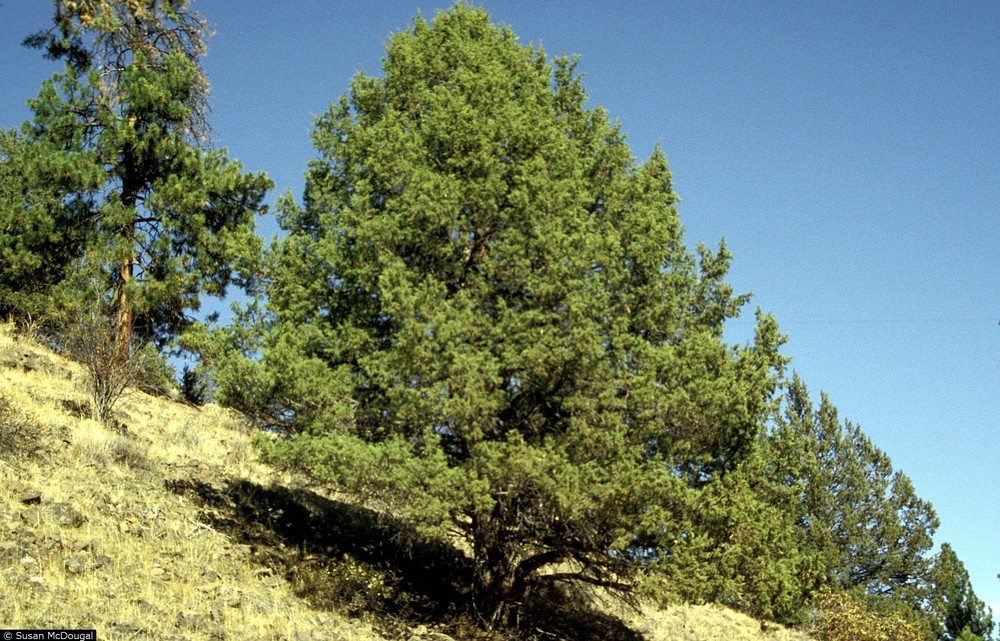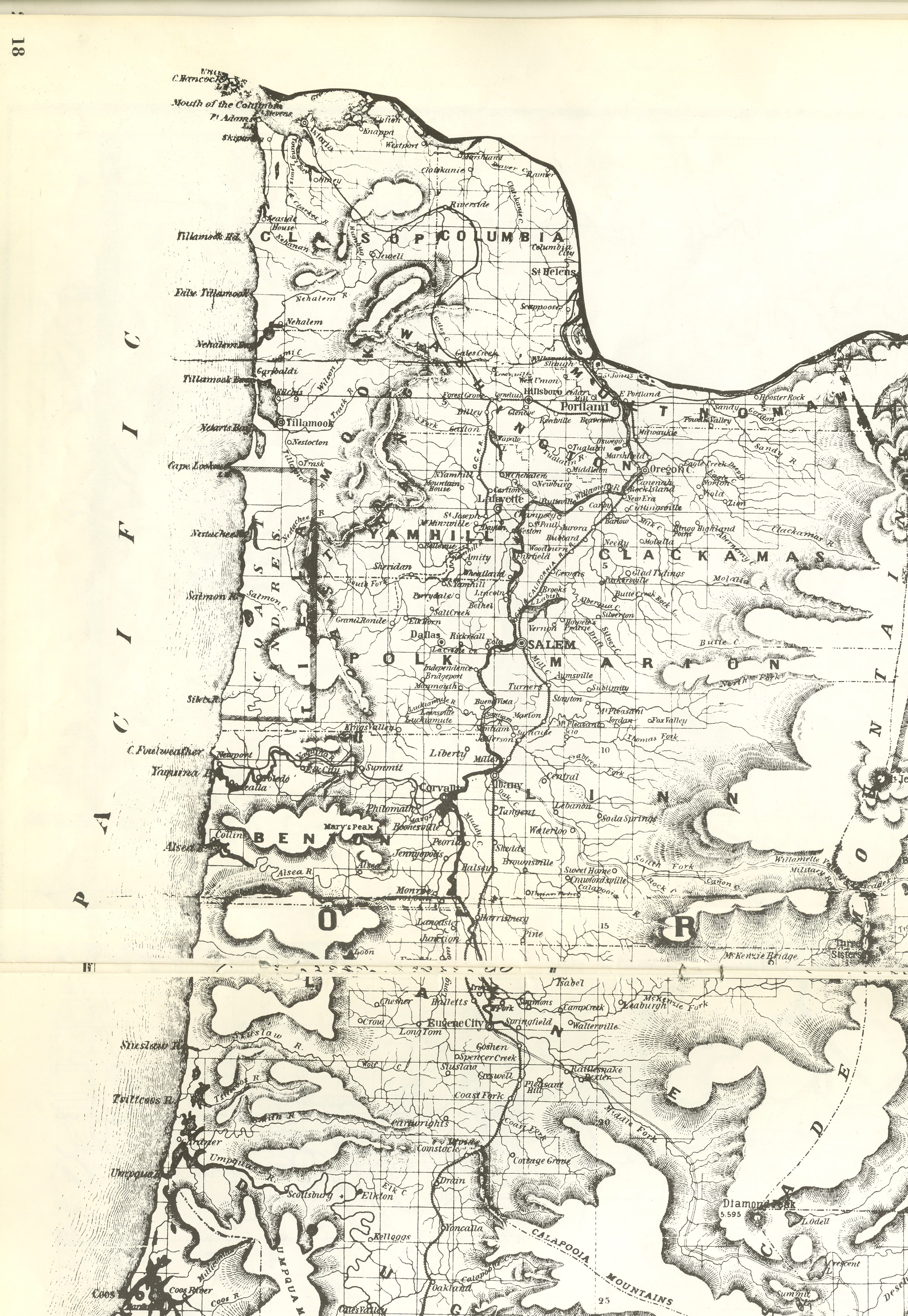Conifers (cone-bearing trees) are the major plant group in Oregon in terms of numbers and biomass. No group of plants has played a greater role in Oregon's history, ecology, and economics than the conifers.
Conifers grow from sea level to mountain tree line throughout the state and dominate the landscape, except in parts of the Willamette Valley and the high desert of central Oregon. Even on the barren plains of the high desert or on mountaintops, however, a distant vista will likely reveal slopes or valley bottoms cloaked with conifers or dotted with scattered individuals. Many conifer species are common particularly to the west of the Cascade Mountains. Other species are restricted to higher elevations in southwest or northeast Oregon.
Except for larch (Larix), conifers are trees and shrubs with evergreen needle-like or scale-like leaves whose male (pollen) and female (seeds) reproductive structures are arranged cones. These cones are composed of a series of bracts, which bear sacs that produce pollen or ovules that form seeds after fertilization. Pollen-producing cones are yellow, red, or purple and are small relative to female cones.
Conifers produce enormous amounts of pollen spread to female cones by wind. Female cones are small and herbaceous at pollination, and they usually mature into brown, woody structures of various sizes. An exception is the berry-like cones of junipers. Conifer wood has specialized cells with bordered pits in their walls that play a role in water conduction. Resin ducts in wood and other tissues produce compounds that protect the trees from invasion by insects or fungi.
We classify conifers as Gymnosperms because no wall encloses their seeds, as in the Angiosperms (the plants with true flowers). Gymnosperms' seeds lie exposed on the upper surface of the female cone scale. There are native gymnosperms in Oregon that are not conifers: the Western yew (a small tree) and several shrubby Mormon tea species. There are also common broad-leaved Oregon trees and shrubs with cone-like structures such as alders (Alnus), which are not conifers. Alders are flowering plants (Angiosperms) with much-reduced female flowers arranged in small cone-like clusters.
Conifers are divided into plant families distinguished by leaf form. Some have "needles" as single leaves along the stem or in clusters of two to many needles (Pine family—Pinaceae); others have modified scale-like leaves that closely clasp the stem or branchlet (Cypress family—Cupressaceae).
Oregon conifers in the Pine Family are false hemlock (Pseudotsuga), the Douglas-fir genus; hemlock (Tsuga), true fir (Abies); pine (Pinus); spruce (Picea); and larch (Larix). Genera in the Cypress Family include Port Orford cedar (Chamaecyparis), Alaska yellow cedar (Xanthocyparis or the older Chamaecyparis), incense cedar (Calocedrus), western red cedar (Thuja); juniper (Juniperus), and Baker cypress (Cupressus).
The Atlas of Oregon describes Oregon as "the nation's leading producer of forest products located in the 'Persian Gulf of timber.'" When Europeans first arrived, the size and number of huge timber-producing trees astounded them. As a source of timber and wood products, the supply of conifers seemed unlimited, and they thought the supply of merchantable timber would last forever.
Today, the timber industry is still an important part of Oregon's economy, but it is not what it was from 1945 to 1999. Among the factors that led to the industry's decline are enforcement of environmental regulations, loss of federal timber, mechanization of mills and logging, departure of private timber companies to the American Southeast.
The new forestry now practiced on Oregon timberlands concentrates on small diameter trees, biomass production, timber salvage from insect and fire damaged trees, and forest restoration and rehabilitation. Under current conditions, a major resurgence to the glory days of Oregon timber harvest seems unlikely. Demand for conifer timber and wood products is down, while production and importation of foreign timber and wood products is up.
Conifers, as a group, are the source of timber products that we use every day. Lumber, boards, beams, fence posts, railroad ties, molding, furniture, window and doorframes, veneer for plywood, wood for musical instruments, pencils, arrow shafts, and hope chests are a few examples. The trees are also used in horticulture, in the production of insects repellent, and in battery baffles and Japanese temples. Finally, and most importantly, conifers play a critical role in forest ecosystem environments, in biogeochemical cycling, and in providing habitat for a myriad of organisms, from spotted owls to soil nematodes, fungi, and bacteria.
-
![Douglas fir cone.]()
Douglas fir, cone of.
Douglas fir cone. Photo by Al Schneider, USDA-NRCS PLANTS Database
-
![Western Hemlock.]()
Western Hemlock 1.
Western Hemlock. Photo by Charles A. Wellner, USDA-NRCS PLANTS Database
-
![Pacific silver fir (Abies amabilis (Douglas ex Louden) Douglas ex Forbes).]()
Pacific silver fir, branch.
Pacific silver fir (Abies amabilis (Douglas ex Louden) Douglas ex Forbes). Photo by Susan McDougall, USDA-NRCS PLANTS Database
-
![Sitka spruce (Picea sitchensis (Bong.) Carrière), 1919.]()
Sitka spruce stumps.
Sitka spruce (Picea sitchensis (Bong.) Carrière), 1919. Photo by N.L. Gary, USDA-NRCS PLANTS Database
-
![Western red cedar (Thuja plicata Donn ex D. Don).]()
Western red cedar branch.
Western red cedar (Thuja plicata Donn ex D. Don). Photo by Susan McDougal, USDA-NRCS PLANTS Database
-
![Western juniper (Juniperus occidentalis Hook. var. occidentalis).]()
Western juniper.
Western juniper (Juniperus occidentalis Hook. var. occidentalis). Photo by Susan McDougall, USDA-NRCS PLANTS Database
Related Entries
-
![Cascade Mountain Range in Oregon]()
Cascade Mountain Range in Oregon
The Cascade mountain system extends from northern California to central…
-
![Douglas-fir]()
Douglas-fir
Douglas-fir (Pseudotsuga menziesii), perhaps the most common tree in Or…
-
![High Desert]()
High Desert
Oregon’s High Desert is a place apart, an inescapable reality of physic…
-
![Port Orford Cedar]()
Port Orford Cedar
Port-Orford-cedar (Chamaecyparis lawsoniana)—also known as white or Ore…
-
![Western hemlock]()
Western hemlock
Western hemlock, or Alaska-spruce (Tsuga heterophylla), is a common con…
-
![Western larch]()
Western larch
Western Larch (Larix occidentalis) often goes unnoticed much of the yea…
-
![Western red cedar]()
Western red cedar
Western red cedar (Thuja plicata) is one of the grand trees that grows …
-
![Willamette Valley]()
Willamette Valley
The Willamette Valley, bounded on the west by the Coast Range and on th…
Further Reading
Farjon, A. A Natural History of Conifers. Portland, Ore.: Timber Press, 2008.
Jensen, E.C., and C.R. Ross. Trees to Know in Oregon. Rev. Ed. Corvallis: Oregon State University Extension Service, 2005.
Loy, W.G., ed. Atlas of Oregon. 2nd ed. Eugene: University of Oregon, 2001.
Van Pelt, R. Forest Giants of the Pacific Coast. Seattle: University of Washington Press, 2001.














